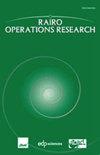基于奖罚机制和消费者环保意识的报废汽车定价策略
IF 1.8
4区 管理学
Q3 OPERATIONS RESEARCH & MANAGEMENT SCIENCE
引用次数: 0
摘要
报废汽车回收与循环经济和可持续发展密切相关,越来越受到各国政府的重视。考虑奖惩机制(RPM)和消费者环境意识(CEA),在由回收中心(TBC)、拆解中心(DC)和政府组成的两级供应链中,讨论了最优回收价格、电动汽车收集努力水平、可用部件拆解水平和RPM强度。首先,利用博弈论构造了Stackelberg和共谋行为模型,得到了最优决策;并对最优解进行了比较,提出了一些建议。最后,通过数值算例研究了CEA波动、报废件销售价格和碳排放节约等参数的影响。结果表明,CEA波动对回收力度和回收量均呈正相关。CEA波动越大,监管压力越大,有利于政府降低监管成本。较高的报废部件销售价格有助于TBC实现较高的回收规模。碳减排和CEA是决定RPM强度和形式的关键。合谋行为模型下的最优决策对参数的变化更为敏感。根据研究结果,政府应采取措施,提高CEA水平,并为企业提供政策支持,以提高ELV回收的效率和效果。DCs应投资于拆解技术并取得突破。废物回收商应采取措施,吸引更多消费者参与废物回收。tbc和dc最好合作,实现整体共赢。本文章由计算机程序翻译,如有差异,请以英文原文为准。
Pricing strategies for end-of-life vehicle regarding reward-penalty mechanism and customers’ environmental awareness
Governments are paying more attention to end-of-life vehicle (ELV) recycling since it is closely related to the circular economy and sustainability development. Considering the reward-penalty-mechanism (RPM) and customers’ environmental awareness (CEA), this study discusses the optimal recycling price, collection effort level of the ELVs, dismantling level of available parts and RPM intensity in a two-echelon supply chain consisting of a take back center (TBC), a dismantling center (DC) and the government. First, two models, Stackelberg and Collusion behaviour models, are constructed by using of game theory and the optimal decisions are obtained. Furthermore, optimal solutions are compared and some propositions are proposed. Finally, a numerical example is illustrated to study the effects of some parameters including CEA fluctuation, sale price of the scrapped parts and carbon emission savings. The results show that CEA fluctuation is always positive for collection efforts and recycling quantity. A higher CEA fluctuation alleviates the regulatory pressures and helps the government reduce regulation costs. A higher sale price of the scrapped parts helps the TBC achieve higher recycling scales. Carbon-emission-savings and CEA are key points in deciding the intensity and form of RPM. The optimal decisions are more sensitive to the change of parameters under the Collusion behaviour model. Based on the findings, the government should take measures to enhance the level of CEA and provide enterprises policy support to enhance the efficiency and effectiveness of ELV recycling. DCs should invest in dismantling technology and achieve breakthroughs. TBCs should take measures to appeal to more consumers to participate in ELV recycling. It is better for TBCs and DCs to cooperate to achieve an overall win-win situation.
求助全文
通过发布文献求助,成功后即可免费获取论文全文。
去求助
来源期刊

Rairo-Operations Research
管理科学-运筹学与管理科学
CiteScore
3.60
自引率
22.20%
发文量
206
审稿时长
>12 weeks
期刊介绍:
RAIRO-Operations Research is an international journal devoted to high-level pure and applied research on all aspects of operations research. All papers published in RAIRO-Operations Research are critically refereed according to international standards. Any paper will either be accepted (possibly with minor revisions) either submitted to another evaluation (after a major revision) or rejected. Every effort will be made by the Editorial Board to ensure a first answer concerning a submitted paper within three months, and a final decision in a period of time not exceeding six months.
 求助内容:
求助内容: 应助结果提醒方式:
应助结果提醒方式:


